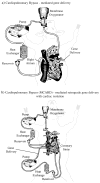Current strategies for myocardial gene delivery
- PMID: 20837022
- PMCID: PMC3683651
- DOI: 10.1016/j.yjmcc.2010.09.003
Current strategies for myocardial gene delivery
Abstract
Existing methods of cardiac gene delivery can be classified by the site of injection, interventional approach and type of cardiac circulation at the time of transfer. General criteria to assess the efficacy of a given delivery method include: global versus regional myocardial transduction, technical complexity and the pathophysiological effects associated with its use, delivery-related collateral expression and the delivery-associated inflammatory and immune response. Direct gene delivery (intramyocardial, endocardial, epicardial) may be useful for therapeutic angiogenesis and for focal arrhythmia therapy but with gene expression which is primarily limited to regions in close proximity to the injection site. An often unappreciated limitation of these techniques is that they are frequently associated with substantial systemic vector delivery. Percutaneous infusion of vector into the coronary arteries is minimally invasive and allows for transgene delivery to the whole myocardium. Unfortunately, efficiency of intracoronary delivery is highly variable and the short residence time of vector within the coronary circulation and significant collateral organ expression limit its clinical potential. Surgical techniques, including the incorporation of cardiopulmonary bypass with isolated cardiac recirculation, represent novel delivery strategies that may potentially overcome these limitations; yet, these techniques are complex with inherent morbidity that must be thoroughly evaluated before safe translation into clinical practice. Characteristics of the optimal technique for gene delivery include low morbidity, increased myocardial transcapillary gradient, extended vector residence time in the coronary circulation and exclusion of residual vector from the systemic circulation after delivery to minimize extracardiac expression and to mitigate a cellular immune response. This article is part of a Special Section entitled "Special Section: Cardiovascular Gene Therapy".
Copyright © 2010. Published by Elsevier Ltd.
Figures








Similar articles
-
Surgical Methods for Cardiac Gene Delivery in Large Animals.Methods Mol Biol. 2022;2573:189-203. doi: 10.1007/978-1-0716-2707-5_15. Methods Mol Biol. 2022. PMID: 36040596
-
A translatable, closed recirculation system for AAV6 vector-mediated myocardial gene delivery in the large animal.Methods Mol Biol. 2011;709:331-54. doi: 10.1007/978-1-61737-982-6_22. Methods Mol Biol. 2011. PMID: 21194039
-
Cardiac gene therapy: optimization of gene delivery techniques in vivo.Hum Gene Ther. 2010 Apr;21(4):371-80. doi: 10.1089/hum.2009.164. Hum Gene Ther. 2010. PMID: 19947886 Free PMC article. Review.
-
Molecular Cardiac Surgery with Recirculating Delivery (MCARD): Procedure and Vector Transfer.Methods Mol Biol. 2017;1521:271-289. doi: 10.1007/978-1-4939-6588-5_20. Methods Mol Biol. 2017. PMID: 27910057
-
Gene transfer and models of gene therapy for the myocardium.Clin Exp Pharmacol Physiol. 1999 Sep;26(9):661-8. doi: 10.1046/j.1440-1681.1999.03117.x. Clin Exp Pharmacol Physiol. 1999. PMID: 10499153 Review.
Cited by
-
Introducer Design Concepts for an Epicardial Parallel Wire Robot.Robot Surg. 2021 Sep 7;8:21-38. doi: 10.2147/RSRR.S327069. eCollection 2021. Robot Surg. 2021. PMID: 34522697 Free PMC article.
-
Nanoparticles administered intrapericardially enhance payload myocardial distribution and retention.J Control Release. 2017 Sep 28;262:18-27. doi: 10.1016/j.jconrel.2017.07.012. Epub 2017 Jul 9. J Control Release. 2017. PMID: 28700900 Free PMC article.
-
Downregulation of the β1 adrenergic receptor in the myocardium results in insensitivity to metoprolol and reduces blood pressure in spontaneously hypertensive rats.Mol Med Rep. 2017 Feb;15(2):703-711. doi: 10.3892/mmr.2016.6038. Epub 2016 Dec 14. Mol Med Rep. 2017. PMID: 28000860 Free PMC article.
-
Analysis of recombinant adeno-associated viral vector shedding in sheep following intracoronary delivery.Gene Ther. 2019 Sep;26(9):399-406. doi: 10.1038/s41434-019-0097-0. Epub 2019 Aug 29. Gene Ther. 2019. PMID: 31467408
-
Advances in locally administered nucleic acid therapeutics.Bioact Mater. 2025 Mar 10;49:218-254. doi: 10.1016/j.bioactmat.2025.02.043. eCollection 2025 Jul. Bioact Mater. 2025. PMID: 40144794 Free PMC article. Review.
References
-
- Melo LG, Pachori AS, Gnecchi M, Dzau VJ. Genetic therapies for cardiovascular diseases. Trends Mol Med. 2005;11:240–50. - PubMed
-
- Donahue JK. Gene therapy for cardiac arrhythmias. Ann NY Acad Sci. 2004;1015:332–7. - PubMed
-
- Bernecker OY, del Monte F, Hajjar RJ. Gene therapy for the treatment of heart failure-calcium signaling. Semin Thorac Cardiovasc Surg. 2003;15:268–76. - PubMed
-
- Ly H, Kawase Y, Yoneyama R, Hajjar RJ. Gene therapy in the treatment of heart failure. Physiology. 2007;22:81–96. - PubMed
-
- Zhang JCL, Woo YJ, Chen JA, Swain JL, Sweeney HL. Efficient transmural cardiac gene transfer by intrapericardial injection in neonatal mice. J Mol Cell Cardiol. 1999;31:721–32. - PubMed
Publication types
MeSH terms
Grants and funding
LinkOut - more resources
Full Text Sources
Other Literature Sources
Medical

